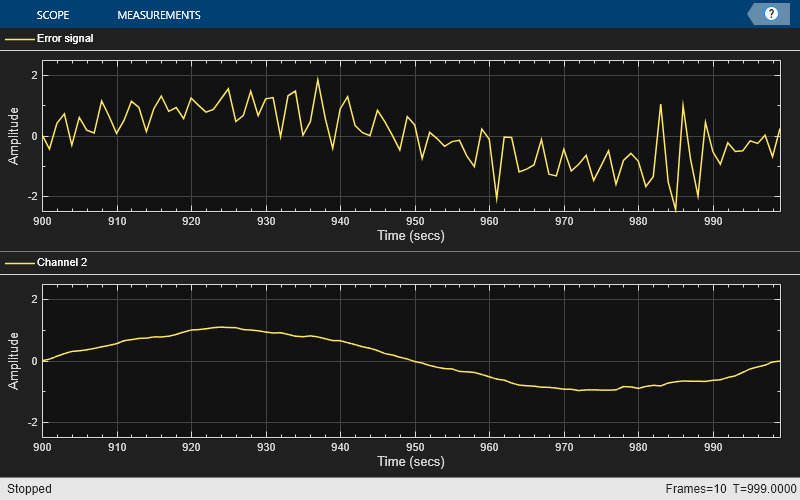dsp.RLSFilter
Compute output, error and coefficients using recursive least squares (RLS) algorithm
Description
The dsp.RLSFilter
System object™ filters each channel of the input using RLS filter implementations.
To filter each channel of the input:
Create the
dsp.RLSFilterobject and set its properties.Call the object with arguments, as if it were a function.
To learn more about how System objects work, see What Are System Objects?
Creation
Description
rlsFilt = dsp.RLSFilterrlsFilt. This System object computes the filtered output, filter error, and the filter weights for a
given input and desired signal using the RLS algorithm.
rlsFilt = dsp.RLSFilter(len)rlsFilt. This System object has the Length property set to
len.
rlsFilt = dsp.RLSFilter(Name,Value)
Properties
Usage
Description
[
shows the output of the RLS filter along with the error, y,e] =
rlsFilt(x,d)e, between
the reference input and the desired signal. The filters adapts its coefficients until the
error e is minimized. You can access these coefficients by accessing
the Coefficients property of the object. This can be done only after
calling the object. For example, to access the optimized coefficients of the
rlsFilt filter, call rlsFilt.Coefficients after
you pass the input and desired signal to the object.
Input Arguments
Output Arguments
Object Functions
To use an object function, specify the
System object as the first input argument. For
example, to release system resources of a System object named obj, use
this syntax:
release(obj)
Examples
Algorithms
The dsp.RLSFilter System object, when Conventional RLS is selected, recursively
computes the least squares estimate (RLS) of the FIR filter weights.
The System object estimates the filter weights or coefficients,
needed to convert the input signal into the desired signal. The input
signal can be a scalar or a column vector. The desired signal must
have the same data type, complexity, and dimensions as the input signal.
The corresponding RLS filter is expressed in matrix form as P(n)
:
where λ-1 denotes the reciprocal of the exponential weighting factor. The variables are as follows:
| Variable | Description |
|---|---|
| n | The current time index |
| u(n) | The vector of buffered input samples at step n |
| P(n) | The conjugate of the inverse correlation matrix at step n |
| k(n) | The gain vector at step n |
| k*(n) | Complex conjugate of k |
| w(n) | The vector of filter tap estimates at step n |
| y(n) | The filtered output at step n |
| e(n) | The estimation error at step n |
| d(n) | The desired response at step n |
| λ | The forgetting factor |
u, w, and k are all column vectors.
References
[1] M Hayes, Statistical Digital Signal Processing and Modeling, New York: Wiley, 1996.
[2] S. Haykin, Adaptive Filter Theory, 4th Edition, Upper Saddle River, NJ: Prentice Hall, 2002.
[3] A.A. Rontogiannis and S. Theodoridis, "Inverse factorization adaptive least-squares algorithms," Signal Processing, vol. 52, no. 1, pp. 35-47, July 1996.
[4] S.C. Douglas, "Numerically-robust O(N2) RLS algorithms using least-squares prewhitening," Proc. IEEE Int. Conf. on Acoustics, Speech, and Signal Processing, Istanbul, Turkey, vol. I, pp. 412-415, June 2000.
[5] A. H. Sayed, Fundamentals of Adaptive Filtering, Hoboken, NJ: John Wiley & Sons, 2003.
Extended Capabilities
Version History
Introduced in R2013a






